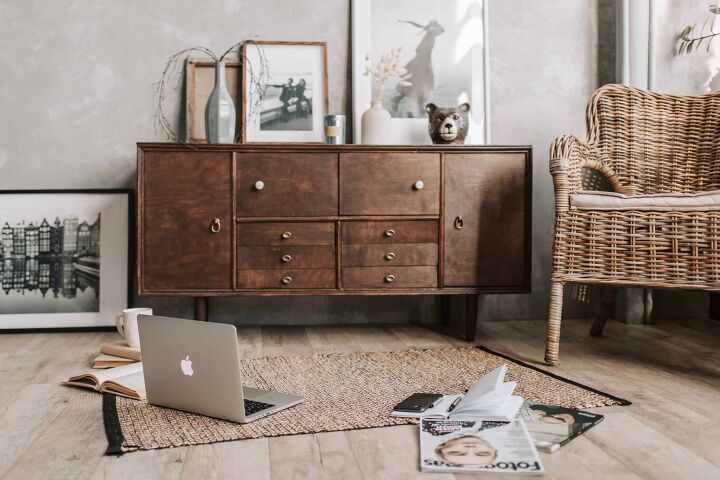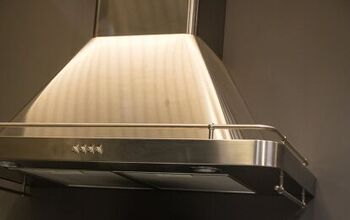How To Paint Knotty Pine Cabinets (In A Few Easy Steps)

Who doesn’t love the unique rusty look of knotty pine cabinets? However, there are times when these cabinets may look worn out and old rather than rustic and chic. What do you do when your cabinets do not go with the interior theme of your home? You paint them.
Painting knotty pine cabinets don’t have to be an ordeal. In reality, it can be quite fun if you understand how to paint them properly without damaging the beautiful quality of the wood. Refinishing knotty pine cabinets to restore their natural beauty can be a fantastic experience and can enhance your kitchen and house’s overall look.
To successfully paint knotty pine cabinets, you’ll need to prepare the cabinets for primer by removing any doors, sand the pine, and to fill in any knot holes. To paint, you’ll need first to choose your paint and then consider if you want to spray or brush the cabinets.
While it is true that painting antique knotty pine cabinets can be challenging as compared to painting knot-free wood, the final outcome is always worth it. Let’s take a detailed look at how to paint your knotty pine cabinets and refinish them with an elegant look.
Do You Need to Hire a Cabinet Refinishing Contractor?
Get free, zero-commitment quotes from pro contractors near you.

How To Properly Paint Your Knotty Pine Cabinets
The first thing that you need to do is to prepare your cabinets for primer and paint. Without an appropriate primer undercoat, the paint will not hold, and a yellowish hue will constantly resurface from under the fresh coat of paint.
Any professional painter will tell you that preparing something for paint is the most essential aspect of painting. So, the first thing that you ought to do is to prepare your cabinets with the help of a primer.
Preparing The Cabinets For Primer
- Remove the cabinet doors. Unscrew the kitchen knotty pine cabinets doors, and remove them from the hinges. Label the doors with numbers, so you don’t mix them later on, and secure all the screws in one place.
- Clean your cabinet doors. As with every form of painting and remodeling, you need to clean the doors and the hinges correctly. Make sure you don’t forget the top surface of the doors to remove any debris, adhesive solutions, and accumulated dirt. You can use any normal detergent or ordinary soap for deep cleaning the doors to remove any surface contaminants.
- Sand down the pine. Whether you are repainting bathroom knotty pine cabinets or kitchen ones, you need to sand the pine properly and the surface to cleanse it and make it ready for primer and paint. You do not need to scrub them down to the bare wood or clean off all the old paint. You just need to sand the surface to strip the clear coat on top for a better primer application.
- Fill in the knots. Fill the knot holes to cover them and render them flush with the surrounding region unless you want your freshly painted pine cabinets to appear rustic. Knots gaps can easily be filled with strong wood filler in the wooden doors.
- Make sure you caulk your cabinet doors. When you are repainting any wooden door or object, you always need to worry about caulking the old surface. The same is the case for your knotty pine cabinets. Look for any recessed panels, and caulk the area to obtain a cleaner and shinier refinishing.
Priming The Knotty Pine Cabinets
Whether you want your knotty pine cabinets painted white or some other color, you need to apply a fresh coat of primer before applying the paint. However, it would be best if you stayed away from using any wrong primers, such as a water-based primer. A water-based primer will not seal the wood, and there will be no use in applying it.
Knotty pine cabinets need to be primed with an oil-based primer or even a shellac-based primer. These primers will not only seal the wood but also prepare the surface to accept a fresh paint of coat with maximum adhesion. Moreover, these primers refrain from the appearance of any discoloration when a new coat of paint is applied.
Without a primer, the paint will look fantastic for a few hours, but discoloration will slowly start surfacing underneath the paint. This bleed-through resembles a yellowish hue and can destroy the overall look of your cabinets. Here are the two best options for priming the cabinets.
Using A Shellac-Based Primer
Shellac-based primers are the number one choice for knotty pine cabinets as this primer is considered an excellent sealer. Not only is it thin, but it also fills in the knotholes quicker and better than any other primer.
For all your cabinets, including knotty pine cabinets with quartz countertops, you can easily use a shellac-based primer as a roll-on primer or as a spray primer. Spraying the primer is better since it doesn’t offer any dripping or splattering.
Using A Oil-Based Primer
The second-best option for a primer is an oil-based primer. While an oil-based primer may not offer the same sealing properties as a Shellac-based primer, it does offer less splattering and messiness. It provides incredible sealing qualities and provides a firm surface bond for paint. The paint will not chip easily if the surface is primed with an oil-based primer.
Painting The Knotty Pine Cabinets
The last step, the one you have been waiting for, is painting the knotty pine cabinets. Once the cabinets have been cleaned, sanded, and primed, it is time to refinish them with appropriate paint.
Choosing The Paint
The paint that you choose is very critical in terms of longevity. If you want long-term benefits and finishing, you should always choose high-quality enamel colors. High-quality enamel paints are worth the additional expenses as these can even out smoother during the application. Moreover, with high-quality enamel paints, the final finishing will be more robust than a cheap latex trim coat.
You wouldn’t want your cabinets chip, dent, or discolor easily, and this is why you need to stay away from using inexpensive paints. If you decide to choose cost-effectiveness over durability for your next home improvement project, you will lose quality and longevity. Using cheap paints will add more days to your refinishing project as you will wind up needing to paint an additional coat to bring out the color or to cover the surface adequately.
Spray vs. Brushing
Lastly, you have to decide between spraying the color or brushing and rolling it onto the surface of antique knotty pine cabinets. While both the options are good, spraying is slowly becoming the preferred option as it requires less energy and time to cover the same amount of area with brushing and rolling. You have to go slow with brushing and rolling and keep applying the paint until you get the desired finish.
On the other hand, spraying the paint offers a superior finish, and it also saves time. All you have to do is cover the surrounding area and use an airless sprayer or an HVLP sprayer to get the job done. Just make sure that you don’t overspray the paint, and you will get an amazing finish with a sprayer rather than with the traditional brushing.
Do I Need To Do Something Different For Kitchen Cabinets?
Do you have knotty pine cabinets in your kitchen, and you want to repaint them? Well, the entire process will remain the same for painting the kitchen knotty pine cabinets with one exception. You will need to varnish the cabinet doors and cabinets after “sanding” them.
Unlike primer, varnish helps the wood retain its rustic qualities and also offers exceptional resistance against ultraviolet light. This way, you can apply a fresh coat of varnish, then primer, and then paint your kitchen cabinets for longevity.
Why do you need to varnish the exterior of your kitchen cabinets? The kitchen is a hot and damp place at the same time. The heat from the oven, ranges, and stoves impacts the cabinets directly. Moreover, occasional spills and water leakage is also a constant danger for kitchen cabinets. An application of varnish will help protect the cabinet wood against heat, water, and UV rays.
Do You Need to Hire a Cabinet Refinishing Contractor?
Get free, zero-commitment quotes from pro contractors near you.

The Bottom Line
When you have to repaint or refinish your kitchen knotty pine cabinets, you can easily get the desired outcome if you stick to the tips mentioned above. However, before you paint, you will need to clean your cabinets and sand them down. This helps to make the primer stick, which will, in turn, make the paint stick.
Then, use an appropriate primer to fill in the knotholes. Finally, choose a high-quality enamel paint to either spray the paint or brush it onto the surface. Make sure you take your time so that you do have a beautiful end result. By rushing, you may not put enough paint on the area, which will result in a messy look. After all, this is your home; you want it to be pleasing to not only your eyes but your guests as well! Good luck!

We are a team of passionate homeowners, home improvement pros, and DIY enthusiasts who enjoy sharing home improvement, housekeeping, decorating, and more with other homeowners! Whether you're looking for a step-by-step guide on fixing an appliance or the cost of installing a fence, we've here to help.
More by Upgraded Home Team















![10 Best Scroll Saws for 2022 [Ultimate Reviews & Buyer's Guide]](https://cdn-fastly.upgradedhome.com/media/2023/07/31/9070684/10-best-scroll-saws-for-2022-ultimate-reviews-buyer-s-guide.jpg?size=350x220)














